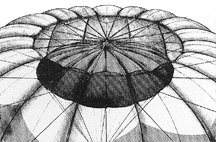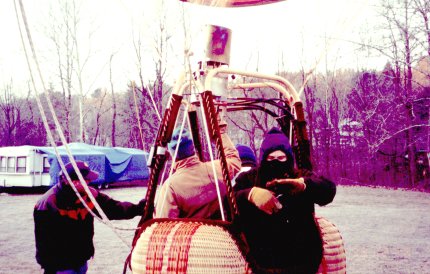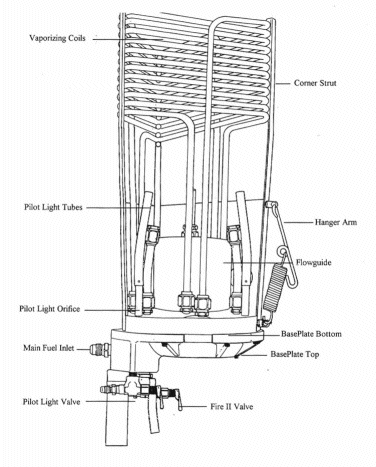
 | |
Balloons are only flown at dawn or within a couple of hours of sunset, since the
winds are calmest when the atmosphere is not being affected as strongly by the
sun.
Today's typical hot air balloon consists of three components:
 | The envelope, the fabric part of the balloon, is typically
constructed of lightweight ripstop nylon having a weight of a couple of
ounces per square yard. It can safely tolerate temperatures up to 250F
or 300F, depending on the manufacturer. It is sewn together. At
the top of the envelope is a vent shaped like a parachute. It can be
opened to release hot air by pulling it inward using a line that reaches to
the basket. The vent re-seals when the line released, so it can be
used both for in-flight rapid cooling of the balloon as well as for
deflating it after landing. Older balloons instead have a Velcro® rip
panel to release hot air but, since it cannot re-seal itself, it is used
only for deflation after landing. The most common envelope size is
about 70,000 cubic feet (carries 2 or 3 people), although they are made as
small as 30,000 cubic feet (single person) and as large as several hundred
thousand cubic feet for balloons flown by commercial ride operators (as many
as 12 people or more).
 |
Diagram of a parachute
vent in operation, from www.theballoonworks.com
the web site of The Balloon Works, manufacturer of Firefly balloons.
Here, the parachute-shaped vent has been
displaced downward and inward away from the rest of the
balloon by pulling a line that extends down to the basket.
|
|
 | The basket or gondola carries the pilot and passengers. It is
typically made of wicker woven around a sturdy wooden, nylon or steel
frame. It also houses the instruments and the fuel tanks for the
burner. Extending upward from the walls of the basket is an upright
solid or flexible superstructure on which the burner is mounted. The
envelope is also attached to this structure, typically using carabiners.
 |
CLAS member Robert
Zirpolo (back to camera), ready to take off with Santo Galatioto
(right) and Mike Russell (in back). The picture shows the basket
with the uprights and the burner mount. The envelope is above,
just out of the picture. |
|
 | The burner or heater generates a hot flame (tens of millions of btu/hour
- several hundred times the power output of a typical home central heating
system) by burning propane stored as liquid in tanks in the basket. No
regulators are used on the tanks; when the pilot opens the blast
valve on the burner, liquid at the full tank pressure passes through the
vaporizing coils and is burned as it emerges from many nozzles in the
burner, ignited by a pilot light that remains lighted during the entire
flight. Since the tank pressure depends on temperature, for flights on
very cold mornings such as this the tanks are kept warming overnight to make
sure the burners work properly. The burner is not in operation all the time, but typically for
several seconds each minute (depending on the outside temperature, balloon
size, weight of passengers, etc.).
 |
Diagram of a typical
burner, the Mirage burner manufactured by The Balloon Works.
Heat from the burning fuel is used to vaporize
more liquid fuel, which passes through the vaporizing coils before
arriving at the burner just. This allows liquid propane to be
burned. It would not be possible to draw enough vapor propane
from a tank without freezing all of the fuel system, since this would
require the heat of vaporization to be supplied by the environment.
|
|
Next: Assembly and Inflation
|



